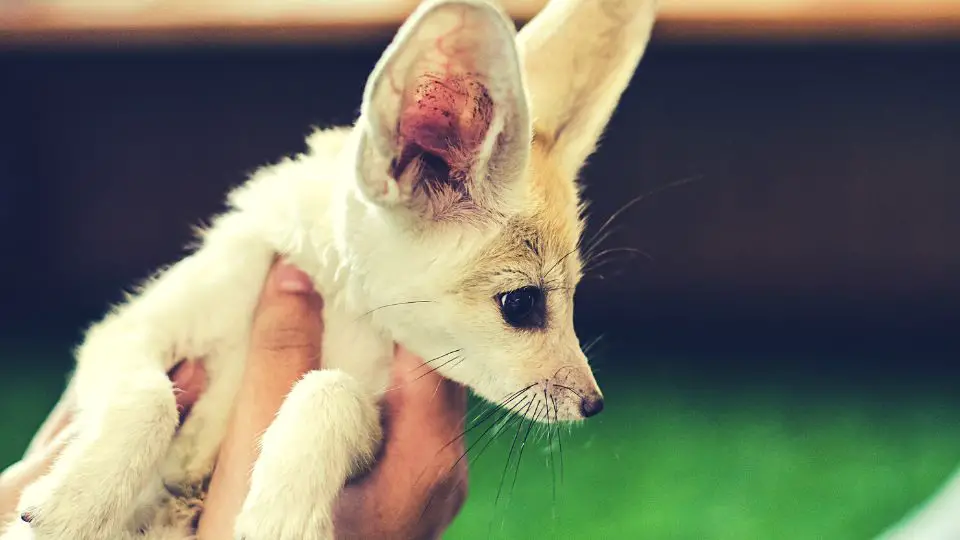Are you considering adding a fennec fox to your household? While these small, cute foxes may seem like appealing pets, they require unique care and considerations.
In this complete guide to keeping fennec foxes as pets, you’ll find everything you need to know about fennec fox biology and behavior, housing and care requirements, feeding and nutrition, common health issues, enrichment and exercise, bonding and interaction, and legal considerations.
Whether you’re a prospective or current fennec fox owner, this guide will provide you with the information you need to provide the best possible care for your furry friend.
Understanding Fennec Fox Biology and Behavior
Fennec foxes are small, desert-dwelling canids native to the Sahara Desert and other parts of North Africa. They are known for their distinctive large ears, which help them dissipate heat and locate prey in the sand. Fennec foxes have soft, dense fur that ranges in color from pale cream to light brown. They are typically small and weigh between 1.5 to 3.5 pounds.
Fennec foxes are social animals that live in family groups of up to ten individuals. They communicate with each other through a range of vocalizations, including yips, barks, and whines, as well as body language. They are primarily nocturnal, and they spend the day sleeping in underground dens that they dig themselves.
One interesting fact about fennec foxes is their special adaptations that allow them to thrive in desert environments. Their large ears help them dissipate heat, and their fur acts as insulation to keep them cool during the hot day and warm at night. Additionally, their kidneys are adapted to conserve water, allowing them to survive without drinking for long periods of time.
Fennec foxes are well-adapted to living in arid desert environments. They are able to go for long periods without water, getting most of the moisture they need from their food. They are also able to regulate their body temperature to cope with the extreme heat of the desert.
Did you know? Fennec foxes have fur on the soles of their feet, which helps them to navigate and insulate their paws in the hot desert sand.
It is important for potential fennec fox owners to understand their behavior and biology in order to provide appropriate care and enrichment. Fennec foxes are not like domesticated dogs and have different needs and behaviors that must be taken into account when keeping them as pets.
Housing and Care Requirements for Fennec Foxes
It is important to understand the housing and care requirements for fennec foxes before bringing one home as a pet. Here are some important factors to consider:
Ideal cage set up for fennec foxes
Fennec foxes need a large and secure cage to live in, with plenty of space for them to move around and play. The cage should be at least 4ft x 4ft x 2ft to provide enough room for them to explore.
The cage should have a hiding place where they can retreat if they feel stressed or scared. The flooring of the enclosure should be solid, without any wire mesh or holes, to prevent foot injuries.
Additionally, the cage should have multiple levels or platforms for the fox to climb on and jump from, as they are natural climbers and enjoy being up high. The cage should also have toys, objects for chewing, and other forms of enrichment to keep the fox mentally stimulated and engaged.
Remember to clean the cage on a regular basis, including removing any waste, replacing the bedding or substrate, and disinfecting surfaces to prevent the buildup of bacteria and parasites.
If you choose to build the cage for your little pet, don’t forget to use materials that are safe for the fennec fox, as they can be prone to chewing and ingesting objects. It should be secure, with a lockable door or gate, to prevent the fox from escaping or other animals from getting in.
Temperature and humidity requirements
Fennec foxes come from a desert environment and are adapted to hot and dry conditions. They need a warm and dry living space with a temperature range of 68 to 86°F. They do not tolerate humidity very well, so keep their living area dry and well-ventilated.
Veterinary care and common health issues
Fennec foxes require regular veterinary checkups to maintain good health. They can be susceptible to health issues like respiratory infections, dental problems, and parasitic infections. Regular vaccinations and parasite prevention measures are important to keep them healthy.
Feeding and Nutrition for Fennec Foxes
Fennec foxes require a balanced diet to maintain their health and wellbeing in captivity. A proper diet should consist of a variety of foods that meet their nutritional requirements, including protein, fat, carbohydrates, vitamins, and minerals.
Nutrient breakdown of a balanced diet
A balanced diet for fennec foxes should include:
- High-quality, low-fat, and low-carbohydrate protein sources such as chicken, turkey, and fish.
- Small amounts of fruits such as apples, bananas, and berries, and vegetables such as carrots, sweet potatoes, and leafy greens.
- Insects such as mealworms, crickets, and silkworms, which provide protein and variety to the diet.
- A source of calcium, such as a supplement or cuttlebone.
Foods to avoid and necessary supplements
Foods to avoid when feeding a fennec fox are:
- High-fat and high-sugar foods: Fennec foxes are prone to obesity, so it’s important to avoid giving them foods that are high in fat and sugar. This includes human foods such as candy, cake, and processed foods.
- Toxic foods: Some common human foods, such as grapes, onions, and chocolate, can be toxic to fennec foxes. It’s important to avoid giving them these foods to prevent serious health issues.
- Dairy products: Fennec foxes are lactose intolerant, so they cannot digest dairy products properly. Avoid giving them milk, cheese, and other dairy products.
Necessary supplements for fennec foxes include:
- Calcium: Fennec foxes require calcium for healthy bone growth and maintenance. A calcium supplement can be added to their diet or provided in the form of bones.
- Vitamins: Fennec foxes require a variety of vitamins to maintain their health, including vitamin A, D, and E. These vitamins can be provided through a balanced diet or supplements.
- Probiotics: Probiotics can help support the digestive health of fennec foxes by promoting the growth of beneficial bacteria in their gut. This can be provided through supplements or through probiotic-rich foods such as yogurt.
Remember to provide supplements in the correct dosages, as over-supplementing can lead to health issues. Consult with a veterinarian or exotic animal specialist for guidance on supplement dosages.
Prey model diet and commercial diets
There are two main types of diets that are commonly fed to fennec foxes: prey model diets and commercial diets.
A prey model diet is based on the idea that fennec foxes are adapted to eating a diet of whole prey in the wild, such as small rodents, birds, and insects. A prey model diet typically consists of whole prey items, such as mice and quail, as well as supplements to ensure that the fox is getting all the nutrients it needs. This type of diet can be more expensive and time-consuming to prepare, but some owners prefer it because it is a more natural diet for the fox.
Commercial diets are formulated to provide a balanced diet for fennec foxes, and are often easier to obtain and prepare than a prey model diet. These diets can come in either dry or wet form and can include ingredients such as chicken, fish, and vegetables. It’s important to choose a high-quality commercial diet that is specifically formulated for fennec foxes, as some general small animal diets may not provide the necessary nutrition.
Both prey model and commercial diets can be appropriate for fennec foxes, and the best diet will depend on the individual fox’s needs and the owner’s preferences. Always consult with a veterinarian or a knowledgeable breeder to determine the best diet for your fennec fox.
Recommended feeding schedule and water needs
The feeding schedule for your small pet may vary depending on the age and individual needs of the fox. Generally, adult fennec foxes should be fed twice a day, in the evening and early morning, to mimic their natural feeding patterns. However, young kits may require more frequent feedings.
Remember to provide fresh and clean water for fennec foxes at all times. Water should be provided in a spill-proof container that is large enough for the fox to drink from easily.
Did you know? Fennec foxes have a specialized kidney system that allows them to survive in their arid desert habitat by conserving water. They are able to obtain most of their required moisture from their diet, and their kidneys are adapted to produce concentrated urine with minimal water loss. This helps them to survive in the harsh desert environment where water is scarce.
Note that fennec foxes may enjoy occasional treats such as fruits or cooked meats, but these should be given sparingly to prevent health problems. Avoid feeding them any toxic or unhealthy foods, as this can cause serious health issues.
If you’re unsure about the best diet and feeding schedule for your fennec fox, consult with a veterinarian who has experience with exotic animals.
Common Health Issues in Fennec Foxes
Fennec foxes are fascinating and unique pets, but like all animals, they are prone to various health issues that can affect their quality of life. Being familiar with the most common health issues that fennec foxes may experience can help you recognize early warning signs and get your pet the necessary medical care in a timely manner.
Respiratory Issues
Respiratory issues are common in fennec foxes, and they can be caused by a variety of factors such as poor ventilation, allergies, infections, and irritants. Symptoms of respiratory issues in fennec foxes may include coughing, wheezing, sneezing, nasal discharge, and difficulty breathing.
Treatment options for respiratory issues in fennec foxes vary depending on the severity and underlying cause of the issue. Mild respiratory infections can be treated with antibiotics, while more severe cases may require hospitalization, oxygen therapy, and other forms of supportive care.
Dental Problems
Dental problems are another common issue in fennec foxes. Fennec foxes have very small teeth, which can make them prone to dental issues such as tartar buildup, periodontal disease, and dental abscesses.
Signs of dental problems in fennec foxes may include bad breath, drooling, reluctance to eat, and pawing at the mouth. Treatment options for dental problems in fennec foxes may include professional dental cleanings, extractions, and antibiotic therapy. To prevent dental issues in fennec foxes, pet owners should provide their pets with a healthy diet, chew toys, and regular dental checkups.
Parasites and Diseases
Fennec foxes are also prone to various parasites and diseases that can negatively impact their health. Common parasites that can affect fennec foxes include fleas, ticks, mites, and intestinal worms. Symptoms of parasitic infections may include itching, hair loss, diarrhea, and weight loss.
In addition to parasites, fennec foxes can also contract various diseases such as distemper, rabies, and mange. Preventive measures for these issues include regular veterinary checkups, flea and tick prevention, and vaccination.
Skin Issues
Skin issues are also common in fennec foxes, and they can be caused by a variety of factors such as allergies, parasites, infections, and nutritional deficiencies.
Signs of skin issues in fennec foxes may include itching, hair loss, redness, and scabs. Treatment options for skin issues in fennec foxes may include topical ointments, antibiotics, and dietary changes.
Nutritional Deficiencies
Fennec foxes require a balanced diet that includes a variety of foods to meet their nutritional needs. A diet that is deficient in essential nutrients such as protein, calcium, and vitamins can lead to a variety of health issues such as metabolic bone disease, obesity, and anemia.
Signs of nutritional deficiencies in fennec foxes may include lethargy, weight loss, and decreased appetite. Preventive measures for nutritional deficiencies in fennec foxes include feeding a balanced diet and providing appropriate supplements as needed.
Enrichment and Exercise for Fennec Foxes
Fennec foxes are active and curious animals that require stimulation to stay healthy and happy. Without enough mental and physical exercise, they can become bored and develop behavior problems such as destructiveness or aggression. Regular exercise and enrichment activities can help keep them mentally and physically stimulated.
Types of enrichment and exercise
There are many types of enrichment and exercise activities that can benefit fennec foxes. Some examples include food-based enrichment such as puzzles and treat-dispensing toys, sensory enrichment like scents and sounds, and environmental enrichment such as providing climbing structures and tunnels.
For exercise, fennec foxes can enjoy indoor activities like playing with toys or running through tunnels, as well as outdoor activities like going for walks and exploring their surroundings.
Ideas for DIY enrichment activities
Here are some DIY enrichment ideas that you can use to keep your fennec fox mentally stimulated and entertained:
- Hide treats in a cardboard box filled with shredded paper or hay for your fox to dig through and find
- Create a puzzle feeder by cutting holes in a plastic container and filling it with food or treats
- Provide a sandbox filled with child-safe play sand for your fox to dig and burrow in
- Make a simple tunnel out of PVC pipes or cardboard boxes for your fox to explore and play in
- Provide a large paper bag or cardboard box for your fox to play and hide in
- Offer various scents for your fox to sniff and explore, such as herbs or essential oils
Combining enrichment and exercise
Combining enrichment and exercise activities can be a great way to keep your fennec fox stimulated and healthy.
You can use food-based enrichment activities to encourage exercise, such as hiding treats around the enclosure for your fox to find, or playing a game of fetch with a favorite toy. By combining the two, your fennec fox will get the mental and physical stimulation they need to stay happy and healthy.
Tips for creating a healthy environment
In addition to providing enrichment and exercise, creating a healthy environment for your fennec fox is crucial to their overall health and well-being. Here are some tips to help you provide a healthy environment for your fennec fox:
- Provide a spacious and secure enclosure with hiding places and plenty of room to move around
- Keep the enclosure clean and free of any potential hazards or contaminants
- Maintain proper temperature and humidity levels, as fennec foxes are adapted to desert climates
- Provide a balanced and nutritious diet that meets their specific dietary requirements
- Provide access to clean and fresh water at all times
- Schedule regular check-ups with a qualified veterinarian to monitor your fox’s health and address any potential health issues early on.
Interacting and Bonding with Your Fennec Fox
Interacting and bonding with your fennec fox can be a rewarding experience that strengthens your relationship with your furry friend. Fennec foxes are social animals that enjoy playing and interacting with their owners, but it takes time and patience to build a strong bond with them.
Many people are not aware that fennec foxes are active and energetic animals that require a lot of attention and interaction. They need daily playtime, exercise, and mental stimulation to prevent boredom and destructive behaviors. This means that they may not be suitable pets for busy individuals who cannot commit to spending a significant amount of time with their fox every day.
Understanding fennec fox communication
Fennec foxes are social animals that use various forms of communication to express themselves. One way they communicate is through body language, which includes things like tail movements, ear positions, and posture. For example, a fennec fox with its tail up and ears alert is likely feeling curious or interested in something, while a fennec fox with its tail down and ears flattened may be feeling scared or threatened.
Fennec foxes also use vocalizations to communicate, including barks, whimpers, and growls. They may make a high-pitched “yip” sound when they’re excited or happy, or a low growl when they’re feeling aggressive or threatened.
Understanding fennec fox communication is important for building a positive relationship with your fox. By paying attention to their body language and vocalizations, you can better understand their needs and feelings, and respond appropriately. This can help to build trust and strengthen your bond with your fennec fox over time.
Tips for building a relationship with your fox
Building a relationship with your fennec fox starts with creating a comfortable and stimulating environment for them. Here is a list of tips for creating a positive bond with your fox:
- Be patient and consistent in your interactions with your fennec fox.
- Spend time with your pet every day, and establish a routine to build trust and familiarity.
- Offer treats and rewards to reinforce positive behaviors.
- Use positive reinforcement training techniques to teach basic commands and tricks.
- Provide opportunities for play and enrichment to bond with your fox and stimulate their mind and body.
- Respect your fox’s boundaries and signals, and avoid forcing interactions.
- Be aware of your fox’s body language and vocalizations to understand their moods and needs.
- Handle your fox gently and respectfully to build trust and avoid injury.
- Consider incorporating outdoor exploration and exercise into your bonding activities.
- Stay current on your fox’s health and wellness needs to provide the best care possible.
How to tame a fennec fox
Taming a fennec fox can be a challenging process, but it is possible with patience, consistency, and positive reinforcement. Here are some steps to follow when taming a fennec fox:
- Start by giving your fennec fox plenty of space and time to adjust to its new environment. Give it a comfortable, quiet place to retreat to if it feels stressed or overwhelmed.
- Slowly begin to introduce yourself to your fennec fox. Sit near the cage and speak to it in a calm, soothing voice. Offer treats or favorite foods through the bars of the enclosure, but avoid making sudden movements or loud noises.
- Once your fennec fox is comfortable with your presence, begin to offer treats from your hand, moving closer to the enclosure over time. Offer treats from a closed fist at first, gradually opening your hand to let the fox take the treat.
- When your fennec fox is comfortable taking treats from your hand, you can begin to offer them outside of the cage. Start in a small, enclosed space like a bathroom or a playpen to minimize the risk of escape. Offer treats and speak to your fox in a calm, reassuring voice.
- Gradually increase the amount of time your fennec fox spends outside of the enclosure, always under close supervision. Offer treats and toys to keep it entertained and reward good behavior with positive reinforcement.
- As your fennec fox becomes more comfortable with you, you can begin to handle it. Start by offering treats while gently petting its head and back. Gradually increase the amount of handling, always watching for signs of stress or discomfort.
- It’s important to remember that fennec foxes are wild animals and may never be fully domesticated. Always approach your fox with respect and caution, and never force it to do something it is uncomfortable with.
Playing and enrichment
Fennec foxes are playful animals that enjoy a variety of toys and games. As we discussed, you should offer your fox a variety of toys, such as puzzle feeders and interactive toys, to keep them mentally stimulated and active. Regular playtime with your fox can also help build a strong bond.
Outdoor exploration
Fennec foxes enjoy exploring their environment and can benefit from outdoor time. However, it’s important to ensure your fox is safe and secure when outdoors, as they are skilled escape artists. Consider using a secure outdoor enclosure or harness for outdoor adventures.
Legal Considerations for Keeping a Fennec Fox as a Pet
Fennec foxes, like many other exotic animals, may be subject to various regulations and permits for ownership in different jurisdictions. It’s important for potential owners to check local and state laws to ensure they can legally keep a fennec fox as a pet.
In some places, a permit or license may be required for owning a fennec fox, and failure to comply with these regulations could result in fines or confiscation of the animal.
Additionally, there are ethical considerations to keep in mind when considering a fennec fox as a pet. These animals are typically wild animals and may not adapt well to living in a domestic environment. It’s important for prospective owners to consider the well-being of the animal and whether they can provide a suitable and stimulating environment.
You should acquire a fennec fox from a reputable breeder or rescue organization, as purchasing from unethical sources can contribute to animal cruelty and exploitation. Overall, it’s crucial to approach owning a fennec fox with responsibility and a commitment to meeting the animal’s needs, both physical and behavioral.
The Pros and Cons of Keeping a Fennec Fox as a Pet
Now that you understand the basics of owning a fennec fox, let’s take a look at some pros and cons of keeping a fennec fox that you should consider before taking on such a responsibility.
Pros of keeping a fennec fox as a pet
- Fennec foxes are unique and interesting animals that are sure to draw attention and admiration from others.
- They can be trained to behave well and form strong bonds with their owners.
- Fennec foxes are relatively low allergenic and produce less dander than many other pets.
- With proper care, fennec foxes can have a long lifespan of up to 11 years in captivity.
- They are adaptable to indoor living and can be litter trained, making them suitable for apartment living.
- Fennec foxes are relatively independent animals and can amuse themselves with toys and activities for hours.
Cons of keeping a fennec fox as a pet
- Fennec foxes have high maintenance and care requirements, requiring specialized diets and environments that can be expensive to maintain.
- They can be difficult to obtain, as their availability is limited and they can be expensive to purchase.
- Legal restrictions and regulations in some areas make it difficult or impossible to keep a fennec fox as a pet.
- Fennec foxes are prone to certain health and behavior problems, and owners must be prepared to provide appropriate care and treatment.
- They require a lot of time and attention, as they need proper socialization and exercise to thrive.
- Fennec foxes are wild animals with natural instincts that can lead to potential aggression or escape if not properly trained and cared for.
- It can be difficult to find a reputable breeder or rescue organization, and owners must be careful to avoid unethical or illegal practices when obtaining a fennec fox.
Wrapping up
In conclusion, keeping a fennec fox as a pet can be a rewarding and enriching experience for those who are willing to provide the appropriate care and environment for these unique animals.
Understanding their biology and behavior, providing adequate housing and nutrition, and engaging in proper enrichment and exercise can help ensure a healthy and happy life for a pet fennec fox. However, it’s important to carefully consider the potential challenges and responsibilities before bringing a fennec fox into your home.
By following the guidelines and tips provided in this guide, prospective fennec fox owners can make informed decisions and provide the best possible care for their new furry companion.







